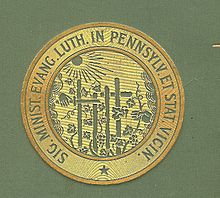Pennsylvania Ministerium
| Pennsylvania Ministerium | |
|---|---|

Seal of the Pennsylvania Ministerium
|
|
| Classification | Protestant |
| Orientation | Lutheran |
| Associations |
General Synod (1820–1823; 1853–1864) General Council (1867–1918) |
| Region | In and near Pennsylvania |
| Founder | Henry Melchior Muhlenberg |
| Origin | August 26, 1748 Philadelphia, Pennsylvania |
| Merged into | United Lutheran Church in America (1918) |
| Other name(s) |
German Evangelical Lutheran Ministerium of North America (1748–1792) |
German Evangelical Lutheran Ministerium of North America (1748–1792)
The Pennsylvania Ministerium was the first Lutheran church body in North America. With the encouragement of Henry Melchior Muhlenberg, the Ministerium was founded at a Church Conference of Lutheran clergy on August 26, 1748. The group was known as the German Evangelical Lutheran Ministerium of North America until 1792, when it adopted the name German Evangelical Lutheran Ministerium of Pennsylvania and Adjacent States.
The Pennsylvania Ministerium was also the source of the first Lutheran liturgy in America. Because of its unique place in the history of North American Lutheranism, the Ministerium continued to influence the church politics of Lutherans in America into the twentieth century.
In 1638, Swedish settlers, colonizing north along the Delaware from the New Sweden colony, established residences in what would become Philadelphia, at a place called Wiccaco by the local Lenape tribe, meaning "pleasant place". These Swedish settlers were Lutheran. The Gloria Dei (Old Swedes’) Church was completed in 1700. Colonization extended to present-day Trenton.
German settlers began arriving in North America in the mid-seventeenth century. They were particularly attracted by William Penn's promise of religious freedom in the colony of Pennsylvania, and came to the Philadelphia region in significant numbers. By 1683, the German population was large enough to form communities such as Germantown (now a neighborhood in Philadelphia). Many of these immigrants brought with them their Lutheran faith and formed congregations in their new homeland.
By the mid-eighteenth century, there was a growing need for well-trained Lutheran clergy in the colonies. With the goal of creating closer union between the preachers, elders, and deacons of the area congregations, a conference was proposed.
The Pietist foundation at the University of Halle in Germany sent 24 clergymen to minister in the colonies in 1742. Among those sent was Henry Melchior Muhlenberg. Tension between pious and orthodox religious interpretations was present in Europe and North American Lutherans at this time. The conference intentionally excluded congregations critical of pious interpretation. A conference was assembled, but disrupted by the orthodox Swedish preacher Rev. Nyburg, of New Sweden colony. Tension around this conference extended beyond Pennsylvania. Open remarks from William C. Berkenmeyer against John C. Hartwick of New York were published in a booklet. Carl M. Wrangel was criticised by his Swedish colleagues in Delaware for having piestic leanings.
...
Wikipedia
